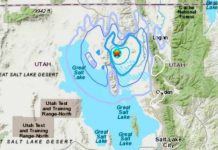
KUMAMOTO, Japan, April 19 (UPI) — Officials in Japan have housed some 250 evacuees in a prison after more than 100,000 people sought emergency shelter in the wake of a series of deadly earthquakes earlier in the week.
The death toll from the three major quakes rose to 47 Tuesday.
Saturday’s two 5.3- and 7.3-magintude earthquakes were preceeded bya 6.4-magnitude quake Thursday near Kumamoto, a city of about 800,000 on Japan’s southwestern Kyushu island.
Another quake occurred Monday in the city of Aso, in Kumamoto prefecture, and in neighboring Oita prefecture. Relief efforts involve tens of thousands of soldiers and emergency personnel, including the U.S. military.
The structural damage has left some people enduring cold temperatures by sleeping in their cars at an exhibition hall parking lot.
Kumamoto Prison opened its doors to victims because, although not a part of codified disaster relief, the prison has a good stock of food and its own water and electricity systems. Its martial arts dojo, used by staff, was open to the public Friday and by Saturday, 250 people, the maximum capacity, were using it.
“This is the first time for a prison to be officially accepting evacuees as a part of regional contribution,” a Justice Ministry spokesman said.
More than 250,000 people were ordered to leave their homes, and aftershocks have been constant, slowing the rescue effort. The Japan Meteorological Agency said further shaking is expected. The quakes were regarded as shallow, and caused massive damage to roads, bridges, rail lines and tunnels. Remote villages have been cut off by landslides and mudslides. Thousands of homes were without electricity, water or gas.
The health consequences of the earthquake also include a potential rise in “economy-class syndrome,” a situation in which blood pools in the legs of people who stay too long in one posture, causing deep vein thrombosis. Named after the phenomenon of sitting in a cramped airplane, the syndrome was blamed for the death of a Kumatomo woman, 51, who had been sleeping in her car. Ten other hospitalized people were identified with the syndrome after the earthquakes.





